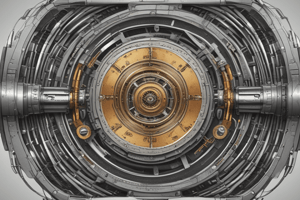Podcast
Questions and Answers
What is the unit of force in the International System of Units (SI)?
What is the unit of force in the International System of Units (SI)?
- Newton (correct)
- Joule
- Pascal
- Watt
According to Newton's first law of motion, what happens to an object when no external forces act on it?
According to Newton's first law of motion, what happens to an object when no external forces act on it?
- It rotates around a central point.
- It remains in a state of rest or uniform motion. (correct)
- It accelerates indefinitely.
- It ceases to exist.
Which of the following represents the equation that relates net force, mass, and acceleration according to Newton's second law of motion?
Which of the following represents the equation that relates net force, mass, and acceleration according to Newton's second law of motion?
- F = ma (correct)
- F = v/t
- F = m + a
- F = a/m
What must be considered when representing force?
What must be considered when representing force?
In the context of forces, what does the term 'vector' refer to?
In the context of forces, what does the term 'vector' refer to?
According to Newton's third law of motion, what occurs during interactions between two objects?
According to Newton's third law of motion, what occurs during interactions between two objects?
Why is the understanding of force important in engineering and science?
Why is the understanding of force important in engineering and science?
What does '1 N' equal in terms of mass and acceleration?
What does '1 N' equal in terms of mass and acceleration?
Flashcards are hidden until you start studying
Study Notes
ខ្នាតកម្លាំងក្នុងប្រព័ន្ធខ្នាតអន្តរជាតិ (SI)
-
ប្រព័ន្ធខ្នាតអន្តរជាតិ (SI):
- ប្រព័ន្ធខ្នាតសកលដែលប្រើសម្រាប់វាស់វែង និងគណនា។
- មានគោលដៅដើម្បីធានានូវការប្រៀបធៀប និងភាពត្រឹមត្រូវក្នុងការវាស់វែង។
-
ខ្នាតកម្លាំង:
- គឺជាការវាស់កម្លាំងដែលប្រើក្នុងការវាស់កម្លាំងនៃវត្ថុ។
-
ខ្នាតកម្លាំងក្នុង SI:
- ខ្នាត: នីយ៉ូតូន (N)
- 1 N = 1 kg·m/s²
- កម្លាំងគឺជាការព្យាយាមសម្រាប់រក្សាឬបម្លែងស្ថានភាពសកម្មភាពនៃវត្ថុ។
- ខ្នាត: នីយ៉ូតូន (N)
-
ច្បាប់នៃកម្លាំង:
- ច្បាប់ទីមួយនៃចលនារបស់នิวតុន: វត្ថុទាំងនោះទាំងមូលដែលមិនមានកម្លាំងចេញពីក្រៅនឹងនៅក្នុងស្ថានភាពស្ងៀមនិងអាចធ្វើដំណើរតាមទិសភាគដើមដូចគ្នា។
- ច្បាប់ទីពីរនៃចលនារបស់នิวតុន: កម្លាំងសុទ្ធសម្រាប់វត្ថុគឺសមស្របនឹងសារពើភ័ណ្ឌនៃការប្រែប្រួលរបស់វា (F = ma)។
- ច្បាប់ទីបីនៃចលនារបស់នิวតុន: សម្រាប់គ្រប់សកម្មភាពប្រកបដោយកម្លាំង គឺមានការប្រឈមគ្នារវាងកម្លាំងចេញពីវត្ថុទាំងពីរ។
-
ការបង្ហាញកម្លាំង:
- ត្រូវតែប្រើវ៉ែកទេស (vector) ដើម្បីបង្ហាញពីទិស និងអំណាចនៃកម្លាំង។
- កម្លាំងអាចបង្កើតដោយគ្រោះថ្នាក់ ឬអនុវត្តសកម្មភាពផ្សេងៗ។
-
សំខាន់នៃកម្លាំង:
- កម្លាំងអាចមានឥទ្ធិពលលើមុខងារនានា រួមមានចលនាវត្ថុ និងការបង្កើតសកម្មភាពផ្សេងៗក្នុងវិស័យវិជ្ជាជីវៈ និងវិស្វកម្ម។
International System of Units (SI)
- An internationally recognized system for measurement and calculation.
- Aims to ensure consistency and accuracy in measurements across different fields.
Unit of Force
- Measures the strength of objects and their interaction.
SI Unit of Force
- Unit: Newton (N)
- Defined as 1 N = 1 kg·m/s².
- Force is an effort applied to maintain or change the state of motion of an object.
Laws of Motion
- First Law (Newton's First Law):
- An object at rest stays at rest, and an object in motion stays in motion unless acted upon by an external force.
- Second Law (Newton's Second Law):
- The net force acting on an object is equal to the mass of that object multiplied by its acceleration (F = ma).
- Third Law (Newton's Third Law):
- For every action, there is an equal and opposite reaction; forces exerted in pairs between two objects.
Representation of Force
- Forces should be represented as vectors to indicate both direction and magnitude.
- Forces can arise from various activities or accidents and are fundamental in analyzing interactions.
Importance of Force
- Influences various functions, including the motion of objects and the generation of different activities in fields like physics and engineering.
Studying That Suits You
Use AI to generate personalized quizzes and flashcards to suit your learning preferences.





